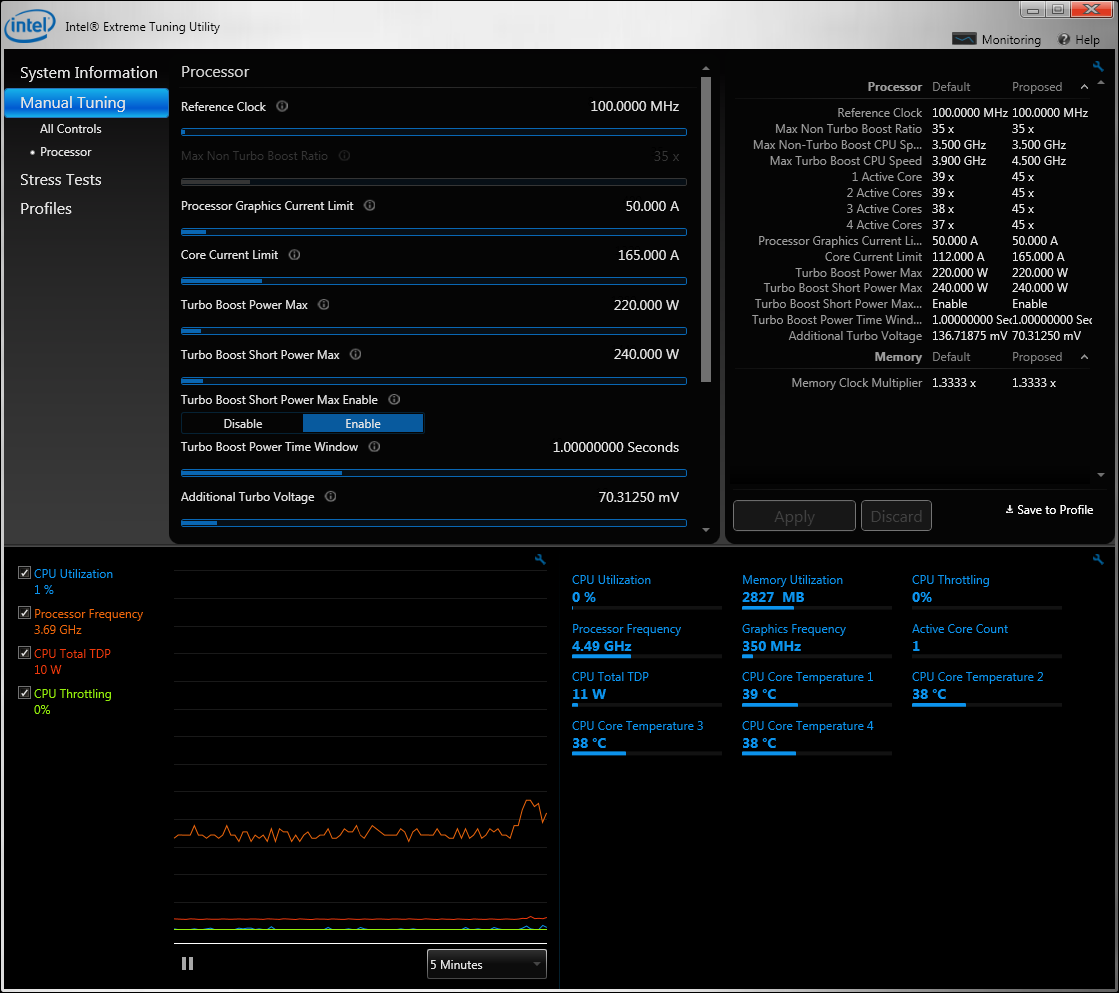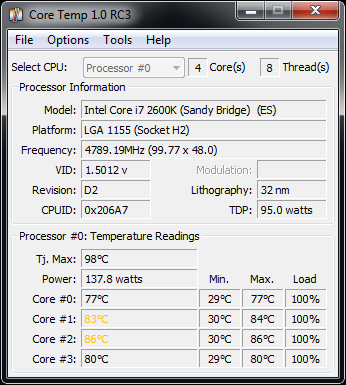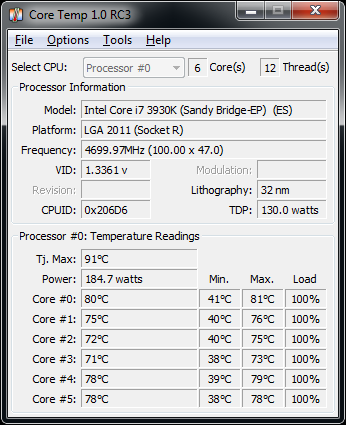Overclocking Core i7-3770K: Learning To Live With Compromise
We recently took our first look at Intel's Ivy Bridge architecture. Then, we evaluated its efficiency. Now, we turn to overclocking. Recently, each of Intel's die shrinks has helped increase frequency headroom. This time, however, we ran into some walls.
Overclocking Ivy Bridge: Treating This Hot-Head Gingerly
Our Core i7-3770K and Core i7-2600K samples ship at very similar clock rates. The Ivy Bridge-based CPU runs at a nominal frequency of 3.5 GHz and can accelerate up to 3.9 GHz with a single core active by virtue of Turbo Boost, providing ample thermal headroom. These clock rates match Intel's Core i7-2700K, flagship of the mainstream Sandy Bridge family. Unfortunately, our only -2700K is in the U.S. So, our German team used a Core i7-2600K it had on hand, which is clocked at 3.4 GHz and capable of reaching 3.8 GHz thanks to Turbo Boost.
Initial Overclocking Successes
This hasn't been talked about a lot, but every overclocker has to appreciate the fact that Intel allows Ivy Bridge-based K-series parts to change their multipliers during operation. It's no longer necessary to reboot between modifications. We've been doing this with our AMD chips for a while now, so kudos to Intel for catching up. Using Intel’s Extreme Tuning Utility, a well-designed utility, we're able to tune our Core i7-3770K from within Windows.
We easily pushed the -3770K above 4 GHz without breaking a sweat. In fact, we hit 4.6 GHz quite easily. There, we encountered our first instabilities, which we tried to counter by raising the core voltage.
Frustration at High Clock Rates
As we proceeded in our overclocking efforts, regardless of whether we used a higher core voltage or not, we observed something frustrating: even below 4.5 GHz, our Ivy Bridge-based Core i7-3770K began thermal throttling. That is to say it reduced its clock rate in order to bring its temperature down. In other words, our overclocked -3770K was already running too hot, even at its default voltage setting.
Core Temp 1.0 RC3 reports that our Core i7-3770K reaches 90-100°C (194-212°F) internally when it's overclocked to 4.5 GHz. No wonder the chip's thermal monitor tripped, throttling the CPU. This phenomenon dropped the effective clock rate of our chip to approximately 3.5 GHz, corresponding to the CPU’s nominal frequency.
Get Tom's Hardware's best news and in-depth reviews, straight to your inbox.
For comparison purposes, let’s look at the Core Temp readouts of Sandy Bridge- and Sandy Bridge-E-based processors:
Our 32 nm Sandy Bridge-based Core i7-2600K also got quite hot on the same test rig. However, each core stayed well below 90°C (194°F). As a result, the system maintained its overclocked frequency of almost 4.8 GHz. That's 300 MHz more than the new Ivy Bridge-based CPU!
Even our six-core Core i7-3960X (Sandy Bridge-E, the one with more than 2.2 billion transistors) posted better temperature readings. Each and every one of the six cores stayed at or below 81°C (176°F) at a very impressive clock rate of 4.7 GHz.
We want to share several observations that will help explain what’s going on.
Current page: Overclocking Ivy Bridge: Treating This Hot-Head Gingerly
Prev Page Ivy Bridge Overclocking: What Does It Entail? Next Page More Voltage, More Heat
Patrick Schmid was the editor-in-chief for Tom's Hardware from 2005 to 2006. He wrote numerous articles on a wide range of hardware topics, including storage, CPUs, and system builds.
-
mayankleoboy1 Nice review!Reply
1. Are there plans to release any K CPU's without the HD4000? will they OC higher?
2. Any chance of intel releasing a second stepping of K-series IB chips? -
mayankleoboy1 i agree that SB chips spoiled the OC world by making OC so easy and fruitful. IB has nothing to compare it to except SB.Reply -
vilenjan Good old Intel. No competition and look what happens, the new generation is barely an upgrade over the previous. Anyone remember Intel PII 450s and the PIII 450s?Reply -
ta152h I'm not sure why the reviewers spent so much time figuring out the shrink made the core more dense, and somehow thought this was significant. I mean, really, this happens virtually every shrink, and this time the power dropped more than normal. Common sense should be telling people this is not the cause, but somehow people aren't understanding this.Reply
It's very interesting that replacing the paste makes so much difference. This is obviously something Intel is aware of, since they do plenty of testing, and obviously chose anyway. Would a few pennies be worth it for a processor that is clearly on the higher end of the scale? Probably not.
Most likely, they want to keep selling their real high end processors, and it just won't do to have the 3770K beating their 2011 processors, or being very competitive with the successors to that line when they come out. It makes perfect sense. The 3770K is still a great processor, but if you're really looking for the best, it simply will not do. You're forced to buy the more expensive 3960X, and later the even better IB successor to it, which you can bet will have far better paste, and so will overclock significantly better.
It's genius. A great product for the vast majority, while leaving more expensive products as the best option for that elite that will actually spend $600 to $1000 for a processor.
Well done, Intel. It's not like AMD has anything to say about it. -
Without the baseline clock for clock comparison (4.5 sandy vs 4.5 ivy), i'm afraid these results are pretty much useless. It's like doing an uncontrolled experiment and passing it off as real science.Reply
-
digiex as the manufacturing process gets smaller = Smaller die size, supposed to be cooler temperature,Reply
but, with small die size = small area for heat dissipation,
...an irony that needs to be solved. -
slicedtoad Recommending a closed loop liquid cooler? really?Reply
They perform worse than decent air coolers. The lower end ones (think corsair's h60) perform like mid-low range air coolers and cost more. The better ones (h100 or antec's 920) perform on par or worse and with more noise than a similarly priced noctua. If noctuas looks too ugly for you, phantek and several others offer similar performing models.
The only reason to get closed loop lc is for looks. I admit they do give your build a nice clean look. That doesn't warrant "So, we're recommending a closed-loop liquid cooling setup, at least" though. If you'd changed that to "We're recommending higher end aftermarket coolers for a decent oc", it would've made more sense.
Anyway, I'm just nit-picking a single line from the article. All in all, it was a good read. It just makes me upset to hear wrong advice. -
_Pez_ there is no performance advantage over the i7 2600k except for power consumption. I better buy an i7-3930k.Reply -
mesab66 Absolutely true, digiex.......not far off the animal world parallel - check out the different temperature regulation methods here between large and small animals, particularly how difficult it is to regulate as the size becomes smaller.Reply -
I would like claims that Ivy Bridge procesor is overheating considerably more then Sandy Bridge addressed. And I thin k Intel really should make a better overall product and not cheat us like this.Reply



